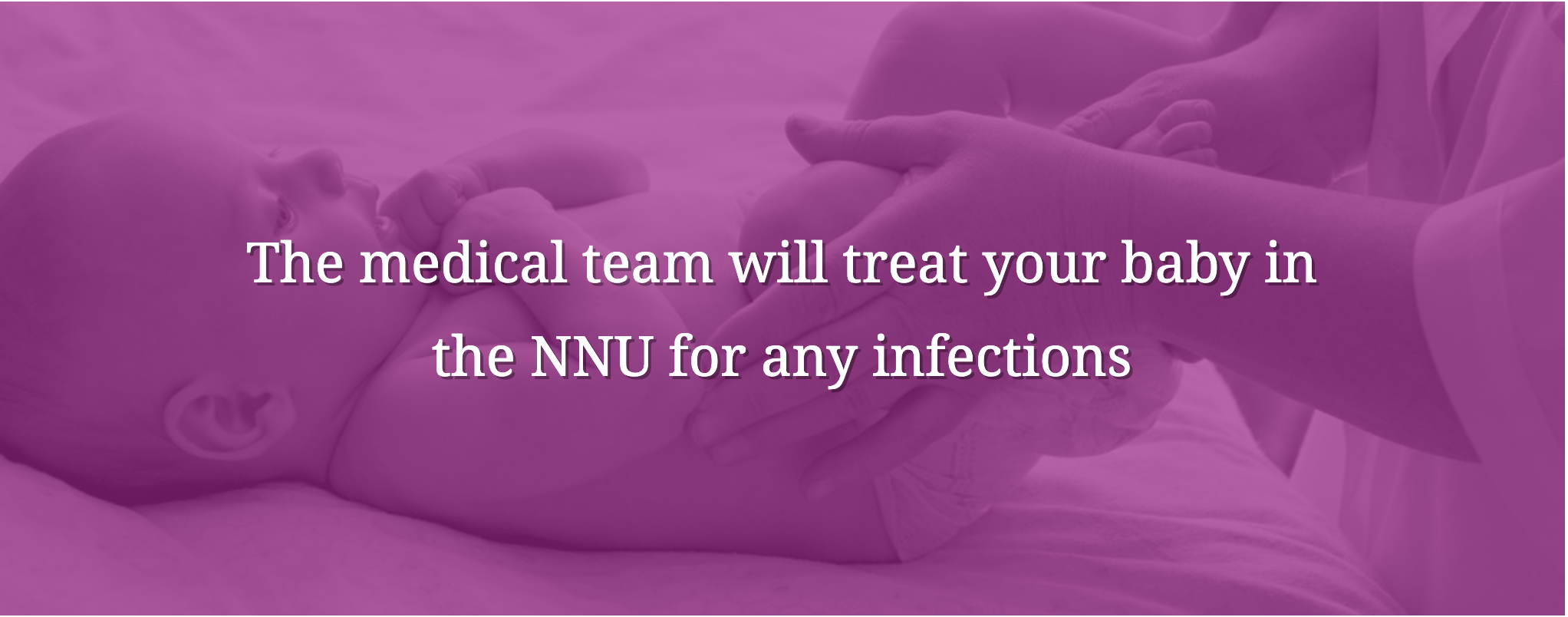Infection
If your baby is suspected of having an infection, they will be admitted to the neonatal unit (NNU). In the event of an actual or suspected contagious/transferable illness, your baby will be cared for in their own isolated room within the NNU. This is part of the neonatal unit’s infection control policy. Below are examples of infections that some babies may experience and need treatment in the NNU.
Neonatal Sepsis
Group B Streptococcus (GBS) is a bacterium that can be found in the vagina, intestines, and rectum of approximately 25 % of healthy, adult women. GBS is of no concern except during pregnancy. Those who test positive for GBS during pregnancy are said to be colonised by GBS, and are at risk of passing GBS to their baby during delivery.
Not every baby who is born to a mother who tests positive for GBS will become ill. On rare occasions (1 in every 2000) a baby can develop a GBS infection, and they can become very ill. Serious illness that occur as a result of GBS include sepsis, pneumonia, meningitis, osteomyelitis, or septic arthritis. Most infected babies show symptoms within 12 hours of birth. The symptoms include being ‘floppy’ and poorly responsive, and not feeding well. Babies that are infected with GBS are treated with antibiotics such as penicillin.
To prevent neonatal sepsis, the policy in Cork University Maternity Hospital is to perform universal screening of all healthcare workers and other high-risk women. At defined times during the antenatal period, swabs are taken from the nose, axilla, and groin. These swabs are tested for GBS. A pregnant woman will be offered antibiotics at labour if she:
- has tested positive for GBS
- has previously had a baby with a GBS infection
- has a high temperature during labour
- goes into labour prematurely
- if she gives birth 18 hours after her ‘waters broke’
High-dose parenteral penicillin or ampicillin administered during labour can interrupt the transmission of GBS, and other bacteria, from mother to baby.
Further Reading: Antenatal screening for Group B Streptococcus: a diagnostic cohort study

Meningitis
Meningitis is the inflammation of the lining that covers the brain and spinal cord. It is usually caused by a bacterial or viral infection. Meningitis in the first month of life (neonatal meningitis) can be a devastating condition which may have neurological implications. The bacteria responsible for neonatal meningitis have remained the same over the past 20 years. These bacteria are Group B Streptococcus (GBS), Escherichia coli (E. coli), Listeria monocytogenes, and Streptococcus pneumonia.
How the baby gets neonatal meningitis depends on the bacteria responsible. GBS is usually transmitted to the baby from the mother’s genital or gastrointestinal tract around the time of birth. Listeria monocytogene is usually transmitted to the baby across the placenta before birth. Mothers with Listeria monocytogene infection generally have a ‘flu-like’ illness in the week, or so, before the baby is delivered.
However, this ‘flu-like’ illness is often not severe enough for recognition that the mother has the infection. It is during this flu-like illness that the bacteria can cross the placenta to infect the baby. These babies who are infected are unwell as soon as they are born. In addition, the infection in the baby may result in premature birth.
Symptoms of meningitis in babies include:
- excessive crying (often different to their usual cry)
- fast or unusual breathing patterns
- fever with cold hands or feet
- not taking feeds or repeated vomiting
- being irritable, especially when handled
- drowsiness.
To diagnose the condition and the bacteria responsible, a lumbar puncture will be carried out. Treatment involves a range of antibiotics.
Pneumonia
Pneumonia is a condition where the lungs are inflamed. It is usually caused by a bacterial or viral infection. If the onset of pneumonia occurs within hours of birth, the condition may be part of a generalised sepsis syndrome. However, if the onset of pneumonia is after 7 days, it’s likely confined to the lungs.
The risk of a baby developing pneumonia is increased in cases where the mother had:
- an unexpected high temperature in labour
- prolonged rupture of membranes
- a meconium-stained or foul smelling liquor/amniotic fluid
- a history of recurrent genitourinary infection in pregnancy.
In the neonatal unit, it commonly occurs amongst babies who require or have had, prolonged endotracheal intubation because of lung disease.
In spite of radiological imaging, pneumonia can be difficult to diagnose in newborn babies because secretions may be difficult to obtain from them. Signs of pneumonia may be limited to respiratory distress, but may also include the following:
- a high temperature, typically over 102 °F
- fatigue
- sleepiness
- weakness
- lack of energy
- laboured breathing
Breathing patterns may be either rapid, but shallow, or from the stomach instead of the chest. These breathing patterns may also be along with excessive nose flaring or wheezing. There is the possibility that your baby will need some help breathing through mechanical ventilation. Your baby may be unable, or too breathless, to feed from the breast or bottle and may require some tube feeds until they are well again.
Diagnosis is made by X-ray, and a clinical and laboratory evaluation if testing for a generalised sepsis syndrome. Treatment is initially with broad-spectrum antibiotics which are changed to organism-specific antibiotics as soon as possible following laboratory results/culture reports. To fight the infection, antibiotics are given through an intravenous line or cannula.

